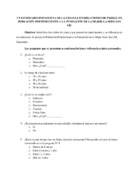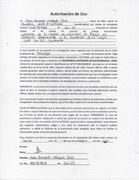Mostrar el registro sencillo del ítem
Influencia de la crianza en relaciones de pareja en población perteneciente a la Fundación de la Mujer sede San Gil, Santander
| dc.contributor.advisor | García Rincón, Eliana Graciela | spa |
| dc.contributor.author | Márquez Silva, María Fernanda | spa |
| dc.contributor.author | Sánchez Rico, Liseth Camila | spa |
| dc.coverage.spatial | San Gil (Santander, Colombia) | spa |
| dc.date.accessioned | 2021-03-15T22:28:41Z | |
| dc.date.available | 2021-03-15T22:28:41Z | |
| dc.date.issued | 2020 | |
| dc.identifier.uri | http://hdl.handle.net/20.500.12749/12424 | |
| dc.description.abstract | El presente estudio evalúa la concordancia de los estilos de crianza y las relaciones con los padres con el fin de identificar su influencia en las relaciones de pareja que se dan en edades adultas. De acuerdo con los objetivos de la presente investigación es identificar los estilos de crianza adoptados por los participantes y su influencia en las relaciones de pareja. Del mismo modo, determinar los imaginarios sociales que poseen las parejas sobre los estilos de crianza y el papel que juegan los padres en la constitución de su estructura emocional y finalmente especificar la diferencia que presentan los participantes en relación a la dependencia emocional. La muestra estuvo constituida por 100 personas (50 mujeres y 50 hombres) para una muestra balanceada. Los resultados obtenidos hacen relación a que los patrones de crianza y la manera en que se conoce el mundo desde el hogar son las bases de las interacciones interpersonales y las relaciones amorosas futuras. | spa |
| dc.description.sponsorship | Fundación Universitaria San Gil UNISANGIL | spa |
| dc.description.tableofcontents | Resumen ......................................................................................................................................... 5 Abstract .......................................................................................................................................... 6 Introducción .................................................................................................................................. 7 Planteamiento del problema ........................................................................................................ 8 Justificación ................................................................................................................................... 9 Objetivos ...................................................................................................................................... 12 Objetivo general .......................................................................................................... 12 Objetivos específicos ................................................................................................... 12 Marco Teórico ............................................................................................................................. 13 Consideraciones Éticas ............................................................................................................... 16 Diseño metodológico ................................................................................................................... 17 Tipo y diseño de la investigación: .............................................................................................. 17 Localización: ................................................................................................................................ 18 Variables ...................................................................................................................................... 18 Estilos de crianza: ................................................................................................. 18 Relaciones de pareja: ............................................................................................ 19 Criterios de Inclusión: ................................................................................................................ 19 Población y Muestra: .................................................................................................................. 19 Técnicas de recolección de datos: .............................................................................................. 19 Procedimiento .............................................................................................................................. 20 Ilustración 1: Procedimiento de la investigación. ........................................................ 20 Resultados .................................................................................................................................... 21 Ilustración 2. Primera pregunta: ¿Cuál es su sexo?, ................................................................... 21 Tabla 1: Categorización. Pregunta 8 ......................................................................... 25 N .................................................................................................................................................... 25 Tabla 2: Categorización. Pregunta 9 ......................................................................... 25 N .................................................................................................................................................... 25 Tabla 3: Categorización. Pregunta 13 ....................................................................... 27 N .................................................................................................................................................... 27 Tabla 4: Categorización. Pregunta 14 ....................................................................... 28 N .................................................................................................................................................... 28 Discusión ...................................................................................................................................... 29 Conclusiones ................................................................................................................................ 31 Referencias................................................................................................................................... 33 Anexos .......................................................................................................................................... 37 | spa |
| dc.format.mimetype | application/pdf | spa |
| dc.language.iso | spa | spa |
| dc.rights.uri | http://creativecommons.org/licenses/by-nc-nd/2.5/co/ | * |
| dc.title | Influencia de la crianza en relaciones de pareja en población perteneciente a la Fundación de la Mujer sede San Gil, Santander | spa |
| dc.title.translated | Influence of parenting in couple relationships in a population belonging to the Fundación de la Mujer headquarters San Gil, Santander | spa |
| dc.degree.name | Psicólogo | spa |
| dc.publisher.grantor | Universidad Autónoma de Bucaramanga UNAB | spa |
| dc.rights.local | Abierto (Texto Completo) | spa |
| dc.publisher.faculty | Facultad Ciencias de la Salud | spa |
| dc.publisher.program | Pregrado Psicología | spa |
| dc.description.degreelevel | Pregrado | spa |
| dc.type.driver | info:eu-repo/semantics/bachelorThesis | |
| dc.type.local | Trabajo de Grado | spa |
| dc.type.coar | http://purl.org/coar/resource_type/c_7a1f | |
| dc.subject.keywords | Psychology | eng |
| dc.subject.keywords | Parenting styles | eng |
| dc.subject.keywords | Relationships | eng |
| dc.subject.keywords | Couple | eng |
| dc.subject.keywords | Emotional dependence | eng |
| dc.subject.keywords | Breeding | eng |
| dc.subject.keywords | Spouses | eng |
| dc.subject.keywords | Family relationships | eng |
| dc.subject.keywords | Conjugal society | eng |
| dc.identifier.instname | instname:Universidad Autónoma de Bucaramanga - UNAB | spa |
| dc.identifier.reponame | reponame:Repositorio Institucional UNAB | spa |
| dc.type.hasversion | info:eu-repo/semantics/acceptedVersion | |
| dc.rights.accessrights | info:eu-repo/semantics/openAccess | spa |
| dc.rights.accessrights | http://purl.org/coar/access_right/c_abf2 | spa |
| dc.relation.references | Agudelo, S., & Gomez, L. (2010). Asociación entre Estilos Parentales y Dependencia Emocional en una Muestra de Adolescentes Bogotanos. Retrieved 11 May 2020, from https://intellectum.unisabana.edu.co/bitstream/handle/10818/1753/131343.pdf?sequence=1 | spa |
| dc.relation.references | Alzugaray, C., & Garcia, F. (2016). RELACIONES DE PAREJA Y BIENESTAR PSICOLÓGICO. Retrieved 11 May 2020, from https://www.researchgate.net/publication/294891178_Relaciones_de_pareja_y_bienestar_psicologico | spa |
| dc.relation.references | Bowlby, J. (1979). LIBRO: VÍNCULOS AFECTIVOS: FORMACIÓN DESARROLLO Y PÉRDIDA (5th ed., pp. https://www.academia.edu/37089039/.Bowlby_J._1986_._Vi_nculos_Afectivos_-_Formacio_n_desarrollo_y_pe_rdida._Ed._Mor). Madrid: EDICIONES MORATA S.A. | spa |
| dc.relation.references | Doe, D. D., & Bersoff, E. H. (1986). The Software Productivity Consortium (SPC): An industry initiative to improve the productivity and quality of mission-critical software. The Journal of Systems and Software, 6(4), 367-378. https://doi.org/10.1016/0164-1212(86)90006-3 | spa |
| dc.relation.references | Gomez, A., Perez, M., Vargas, G., & Wilthew, M. (2010). Retrieved 11 May 2020, from https://www.psicoterapiarelacional.es/Portals/0/eJournalCeIR/V4N2_2010/11-Gomez-Alva-et-al_Evaluacion-del-apego_CeIR_V4N2.pdf?ver=2010-07-03-101900-000 Influencia de la Crianza en Relaciones de Pareja | spa |
| dc.relation.references | Gómez-Zapiain, Ortiz, Gómez-Lope. (2011) Experiencia sexual, estilos de apego y tipos de cuidados en las relaciones de pareja. Anales de psicología, 2011, vol 27, nº 2 (mayo) 447-456. Tomado de https://revistas.um.es/analesps/article/view/123081/115711 | spa |
| dc.relation.references | Lemos, M., & Londoño, N. (2020). 1. CONSTRUCCIÓN Y VALIDACIÓN DEL CUESTIONARIO DE DEPENDENCIA EMOCIONAL EN POBLACIÓN COLOMBIANA. Retrieved 11 May 2020, from http://www.scielo.org.co/scielo.php?pid=S012391552006000200012&script=sci_abstract&tlng=es | spa |
| dc.relation.references | Ley 1090 de 2006, Congreso de Colombia, Tomado de: https://www.funcionpublica.gov.co/eva/gestornormativo/norma.php?i=66205 | spa |
| dc.relation.references | Martinez, J., Fuentes, A., Orgaz, B., Vicario, I., & Gonzalez, E. (2014). 3. VÍNCULOS AFECTIVOS EN LA INFANCIA Y CALIDAD EN LAS RELACIONES DE PAREJA DE JÓVENES ADULTOS: EL EFECTO MEDIADOR DEL APEGO ACTUAL. Retrieved 11 May 2020, from http://scielo.isciii.es/scielo.php?script=sci_arttext&pid=S0212-97282014000100022 | spa |
| dc.relation.references | Momeñe, J., & Estévez, A. (2018). LOS ESTILOS DE CRIANZA PARENTALES COMO PREDICTORES DEL APEGO ADULTO, DE LA DEPENDENCIA IA EMOCIONAL Y DEL ABUSOPSICOLÓGICO EN LAS RELAC IONES DE PAREJA ADULTAS. Retrieved 11 May 2020, from https://www.researchgate.net/publication/337533926_LOS_ESTILOS_DE_CRIANZA_PARENTALES_COMO_PREDICTORES_DEL_APEGO_ADULTO_DE_LA_DEPENDENCIA_EMOCIONAL_Y_DEL_ABUSO_PSICOLOGICO_EN_LAS_RELACIONES_DE_PAREJA_ADULTAS | spa |
| dc.relation.references | Ojeda, A., Estevez, J., & Ganzales, G. (2014). 3. “SER PAREJA” ES APRENDER DEL LADO OSCURO DE LA RELACIÓN Y FORTALECER SU VÍNCULO APEGO-DESAPEGO. Retrieved 11 May 2020, from https://www.researchgate.net/publication/315663047_Ser_Pareja_es_aprender_del_lado_oscuro_de_su_relacion_y_fortalecer_su_vinculo_apego-desapego | spa |
| dc.relation.references | Ortiz, D., Acosta, P., Rubio, D., Lepe, N., Del Valle, M., & Cadena, D. et al. (2019). CONSIDERACIONES TEÓRICAS ACERCA DEL APEGO EN ADULTOS. Retrieved 11 May 2020, from http://revistas.unife.edu.pe/index.php/avancesenpsicologia/article/view/179 | spa |
| dc.relation.references | Otero, O., Zabarain, S., & Fernandez, M. (2017). 3. ESTILOS DE APEGO, COMUNICACIÓN Y CONFIANZA ENTRE PADRES Y JÓVENES UNIVERSITARIOS DE LA GUAJIRA – COLOMBIA. Retrieved 11 May 2020, from https://www.researchgate.net/publication/323525060_Estilos_de_apego_comunicacion_y_confianza_entre_padres_y_jovenes_universitarios_de_la_Guajira-_Colombia | spa |
| dc.relation.references | Perez, B., & Arrazola, E. (2012). VÍNCULO AFECTIVO EN LA RELACIÓN PARENTO-FILIAL COMO FACTOR DE CALIDAD DE VIDA. Retrieved 11 May 2020, from https://dialnet.unirioja.es/descarga/articulo/4929410.pdf | spa |
| dc.relation.references | Sampieri, H., Collado, F., & Lucio, B. (1997). Metodología de la investigación. Recuperado a partir de http://josetavarez.net/Compendio-Metodologia-de-la-Investigacion.pdf.Vanegas, | spa |
| dc.relation.references | J. (2011). LA DINÁMICA VINCULAR CELOS-INFIDELIDAD. Retrieved 11 May 2020, from http://www.scielo.org.co/pdf/pepsi/v9n17/v9n17a09.pdf | spa |
| dc.subject.lemb | Psicología | spa |
| dc.subject.lemb | Crianza | spa |
| dc.subject.lemb | Conyúgues | spa |
| dc.subject.lemb | Relaciones familiares | spa |
| dc.subject.lemb | Sociedad conyugal | spa |
| dc.identifier.repourl | repourl:https://repository.unab.edu.co | spa |
| dc.description.abstractenglish | The present study assesses the concordance of parenting styles and relationships with parents in order to identify their influence on couple relationships that occur in adulthood. According to the objectives of this research, it is to identify the parenting styles adopted by the participants and their influence on couple relationships. In the same way, to determine the social imaginaries that couples have on parenting styles and the role that parents play in the constitution of their emotional structure and finally specify the difference that the participants present in relation to emotional dependence. The sample consisted of 100 people (50 women and 50 men) for a balanced sample. The results obtained relate to the fact that parenting patterns and the way in which the world is known from home are the bases of interpersonal interactions and future love relationships. | eng |
| dc.subject.proposal | Estilos de crianza | spa |
| dc.subject.proposal | Relaciones | spa |
| dc.subject.proposal | Pareja | spa |
| dc.subject.proposal | Dependencia emocional | spa |
| dc.type.redcol | http://purl.org/redcol/resource_type/TP | |
| dc.rights.creativecommons | Atribución-NoComercial-SinDerivadas 2.5 Colombia | * |
| dc.coverage.campus | UNAB Campus Bucaramanga | spa |
| dc.description.learningmodality | Modalidad Presencial | spa |
Ficheros en el ítem
Este ítem aparece en la(s) siguiente(s) colección(ones)
-
Psicología [1091]




